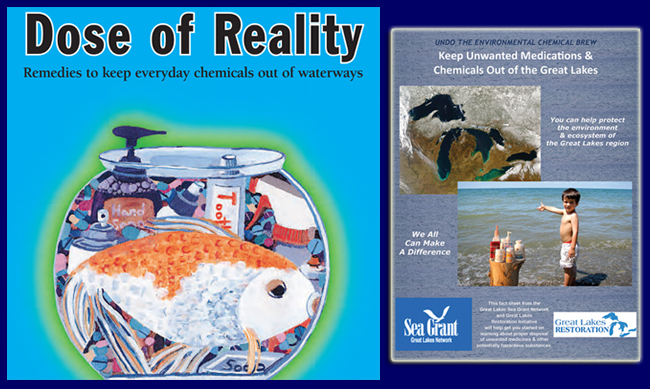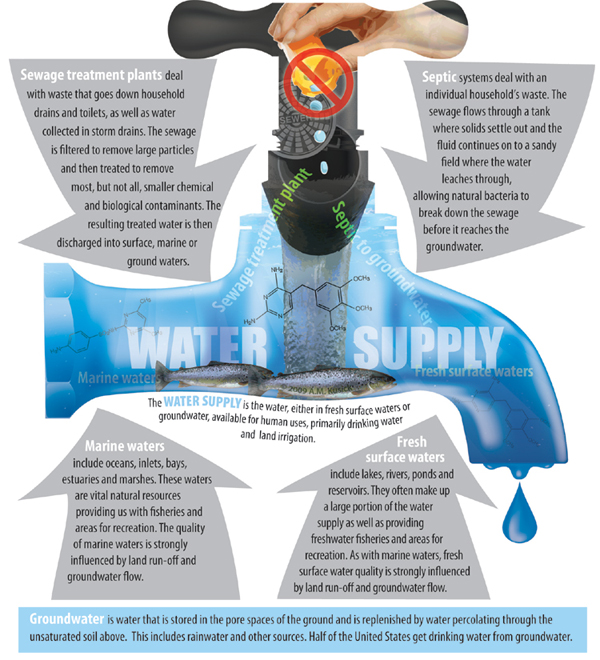National Drug Take-Back Day Is Saturday, April 30: Spring Cleaning For Your Medicine Cabinet
Contact:
Helen Domske, NY Sea Grant's Coastal Education Specialist, P: 716.645.3610, E: hmd4@cornell.edu
Buffalo, NY, April 29, 2016 - Open up your medicine cabinet or first-aid closet tonight after work or tomorrow morning and ask yourself:
- How many bottles of prescription medicines have I accumulated that I no longer take?
- Do I have any medicines that are past their expiration date?
- Am I perhaps responsible for cleaning out the home of a recently deceased friend or relative, particularly someone older who might have been taking a litany of medicines?
For four hours this Saturday (April 30, 2016)—from 10 am - 2 pm your local time—you can safely dispose of these medicines at a registered site in your community as part of The U.S. Drug Enforcement Agency's (USDEA) "National Prescription Drug Take-Back Day."
The reason for such events is clear: Unwanted prescription drugs that are improperly disposed of can pollute local waterways, posing a threat to public health, wildlife, and our natural environment. The United States Geological Survey (USGS) has detected trace amounts of antibiotics, hormones, contraceptives, steroids, and other medications in 80% of the water tested throughout the country. Flushing and landfilling unused medications are never the right disposal solutions.
"Participating in this biannual event is an easy step to help preserve the health of New York's Great Lakes and marine waters," says New York Sea Grant's Coastal Education Specialist
Helen Domske. "It also helps reduce the misuse of pharmaceuticals, which can also impact human health." NYSG offers resources to "Returning Unwanted Medicines" at
www.nyseagrant.org/unwantedmeds.
“We want people to stop flushing pharmaceuticals down the toilet or the drain,” says Domske. "We tell people not to flush them down the drain because it does eventually get out to into the water system."
Saturday's event marks the 10th time since September 2010 that the USDEA has partnered with federal, state and local law enforcement to collect any unwanted medicines for safe disposal. At the last event, in September 2015, Americans turned in 350 tons (over 702,000 pounds) of prescription drugs at more than 5,000 sites operated by the USDEA and more than 3,800 of its state and local law enforcement partners. Overall, in all the previous Take Back events, USDEA and its partners have taken in over 5.5 million pounds—more than 2,750 tons—of pills.
"These take-back events highlight the problems related to prescription drug abuse and provide a unique and meaningful service to our citizens," said USDEA Acting Administrator
Chuck Rosenberg. "While we continue to finalize a uniform system for prescription drug disposal, we will continue to sponsor these take-back opportunities and give Americans the opportunity to contribute to the solution. DEA is grateful to the many federal, state, local, and tribal partners that have helped make this effort so successful."
What You Can Do
How can you get rid of your old medicines this Saturday? Visit the
National Take Back Initiative Collection Site Search to punch in your zip code and find an authorized drug disposal site near you. Additional information on the Take Back days can be found at
USDEA's National Take Back Initiative's Web site.
The
U.S Food and Drug Administration provided a comprehensive list of drugs that it recommends for disposal via the sink or toilet.
In addition to
Sea Grant's "Return Unwanted Medicines" resources, our program offers a number of other "
Great Tips for Coastal Living."
Sea Grant's Research & Education Efforts on Pharmaceuticals in our Waterways
One of the issues addressed by National Drug Take-Back Day is wastewater contamination from the flushing of drugs down the toilet. As research from New York Sea Grant and others have shown, estrogen and its breakdown products (metabolites) are known to be responsible for the feminization of fish downstream from wastewater treatment plants. While not much can be done about the urine from people taking estrogens as a hormone replacement therapy or oral contraceptive, keeping unused pills out of the water supply is environmentally sound.
In a New York Sea Grant-funded research project that began this past February, Stony Brook University researcher
Anne McElroy is leading a two year study that examines the effectiveness of advanced treatment options, environmental levels and potential effects of pharmaceuticals in New York waters.
The reason for this study is that pharmaceutically-active ingredients (APIs), including drugs, personal care products and their metabolites, form a group of "contaminants of concern" that have dominated recent discussions about human and environmental health of NY's Great Lakes and marine coastal surface waters.
"The number of APIs and their known or suspected active metabolites in coastal waters is in the hundreds and continues to increase," says McElroy. "So, data collected from our project will help to fill important data gaps and enhance knowledge about sewage-derived APIs and their effects on fish behavior and how well advanced wastewater treatment technologies reduce API discharges and mitigate these effects."

On the education front, Sea Grant programs in five Great Lakes states have worked with law enforcement agencies through its "Dose of Reality Campaign" to reduce the quantity of prescription medications that are washed down sinks and toilets, thereby reducing the risk of biologically active compounds in drugs contaminating lakes, rivers and drinking water sources.
The efforts of NYSG's Helen Domske and other extension and education specialists throughout these five Great Lakes Sea Grant programs—in Pennsylvania, Illinois, Indiana, New York and Ohio—were recognized in Fall 2013 as a Top 100 Great Lakes Restoration Initiative Success Story. It was the second award that NYSG's Domske had received for this campaign in as many years. In October 2012, the Great Lakes Sea Grant Extension Network bestowed upon her an Outstanding Outreach Award for public education programming related to “Dose of Reality."
Domske has helped consumers learn how to properly keep pharmaceuticals and personal care products (PCPs) out of surface waters with her publication “
Undo the Environmental Chemical Brew: Keep Unwanted Medications & Chemicals Out of the Great Lakes” (
pdf). "Brew" was co-produced by New York, Illinois-Indiana, Ohio and Pennsylvania Sea Grant programs with funding through the Environmental Protection Agency's Great Lakes Restoration Initiative.
Domske’s four-page primer—which highlights points made in a 12-page
Dose of Reality publication (
pdf)—covers the impact of such substances as antibiotics, antidepressants, birth control pills, cosmetics, and even vitamins on the freshwater Great Lakes system that supplies drinking water to 42 million people in the U.S. and Canada.

When pharmaceuticals are flushed, they enter household septic systems or
sewage treatment plants and can make their way into our waterways or
even water supply. Follow the diagram to see how.
Information courtesy
of Stony Brook University (SBU) School of Marine and Atmospheric
Sciences researcher Dr. Henry Bokuniewicz and SBU graduate student Ruth
Coffey. Illustration by Anita Kusick.
More Info: New York Sea Grant
New York Sea Grant (NYSG), a cooperative program of Cornell University
and the State University of New York, is one of 33 university-based
programs under the National Sea Grant College Program (NSGCP) of the
National Oceanic and Atmospheric Administration (NOAA). The NSGCP
engages this network of the nation’s top universities in conducting
scientific research, education, training and extension projects designed
to foster science-based decisions about the use and conservation of our
aquatic resources. Through its statewide network of integrated
services, NYSG has been promoting coastal vitality, environmental
sustainability, and citizen awareness about the State’s marine and Great
Lakes resources since 1971.
New York Sea Grant maintains Great Lakes offices at SUNY Buffalo, the
Wayne County Cooperative Extension office in Newark and at SUNY Oswego. In the State's marine waters, NYSG has offices at Stony Brook University and Stony Brook Manhattan, in the Hudson Valley through Cooperative Extension in Kingston and at Brooklyn College.
For updates on Sea Grant activities:
www.nyseagrant.org has RSS,
Facebook,
Twitter, and
YouTube links. NYSG also offers a free e-list sign up via
www.nyseagrant.org/coastlines for its flagship publication,
NY Coastlines/Currents, which is published several times a year.